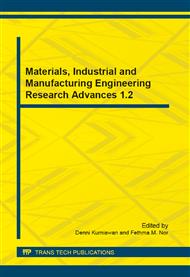p.35
p.41
p.47
p.51
p.55
p.61
p.67
p.73
p.79
Effect of Heat Treatment on Tensile Strength and Microstructure of AZ61A Magnesium Alloy
Abstract:
Magnesium alloys are the very progressive materials whereon is due to improve their end-use properties. Especially, wrought Mg alloys attract attention since they have more advantageous mechanical properties than cast Mg alloys. Investigations were carried out the effects of heat treatment on tensile strength and microstructure of AZ61A magnesium alloy. The AZ61A Mg alloy is solution heat treated at the temperature of 6500F (343°C) for various soaking timing such as 120 min, 240 min and 360 minutes and allowed it cool slowly in the furnace itself. Magnesium alloys usually are heat treated either to improve mechanical properties or as means of conditioning for specific fabrication operations. Special attention had been focused on the analysis of mutual relations existing between the deformation conditions, microstructural parameters, grain size and the achieved mechanical properties. The result after the solution heat treatment, showed remarkably improved hardness, tensile strength and yield strength. It would be appropriate for a forming process namely isostatic forming process.
Info:
Periodical:
Pages:
55-59
Citation:
Online since:
August 2014
Authors:
Keywords:
Price:
Сopyright:
© 2014 Trans Tech Publications Ltd. All Rights Reserved
Share:
Citation:


